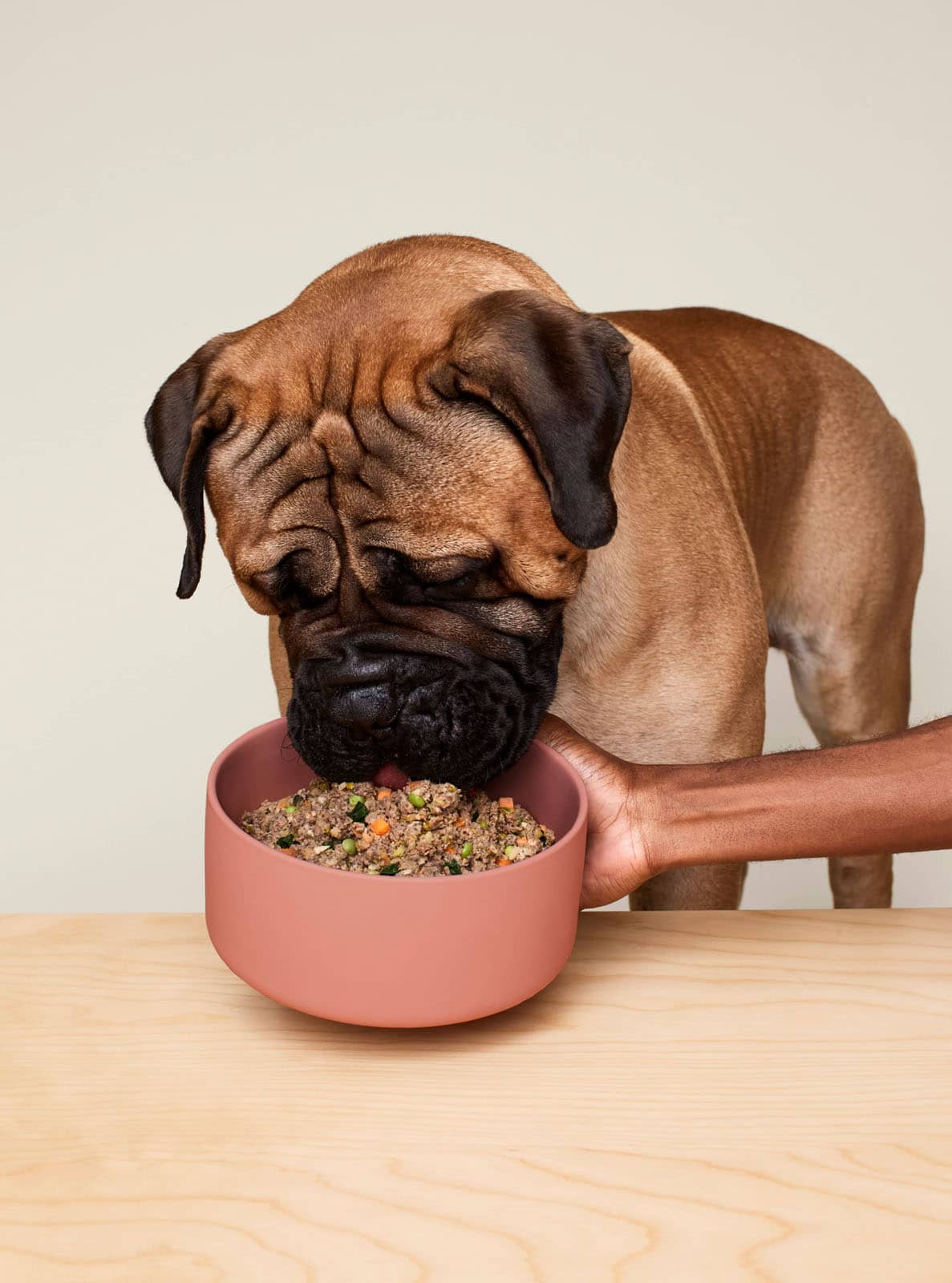We may earn money or products from the companies mentioned in this post at no additional cost to you.
For decades Fido or Buttercup only had a couple options for dog food – dry kibble or wet mush. Most pet owners had no idea what went into these mystery foods but other than cooking themselves there were no better options. The dog food industry was largely unregulated, and the label never told the whole story. Thankfully for your pooch – times have changed.
Nearly every pet store and online outlet now features dozens of different dog food brands and types from dry to kibble to the most decadent fresh food. Fresh dog food is the one we want to discuss.
You’ve been told by your doctors and health experts that fresh, unprocessed foods are the best for your body – so why would it be different for your dog? Fresh dog food provides nutrients, minerals, and everything else your dog needs for a happy and healthy life. These reasons and more have made fresh dog food the fastest growing segment of the pet food industry.
If it’s time to switch your pooch from mystery kibble to fresh food you need something reliable and well-reviewed, like The Farmer’s Dog and Ollie fresh dog food. Revoupon has done the research and will put these two brands up against typical store-bought dog food, up against other diets, and up against each other to give you a wide overview of pros and cons.
Let’s learn why regular dog food isn’t the best idea, how fresh food measures up against generic dog foods, and whether Ollie or The Farmer’s Dog subscriptions are the best fresh food for your dog.
What’s Wrong with Regular Dog Food?
Let’s preface this section with something important – regular dog food is not inherently bad. Most dogs in the United States eat dry kibble and most dogs are healthy and happy. Dog owners that feed their dog dry kibble shouldn’t feel wrong, but they should know there are other, better options. Let’s start with what’s in a typical bag of store-bought dry dog food.
What About Grain Free Dog Food?
Grain free dog foods like Blue Buffalo and Taste of the Wild have become popular but most dog owners are misinformed about their grain free diets. Let’s clear these up with some myths and facts. Click to see the facts about grain-free dog food:
The Bottom Line on Dry Kibble – Generic dog kibble is often manufactured from questionable parts of animals and plants, is cooked dry of its bulk nutrition, and can leave both owner and pet wanting. It will do the job but it’s not the best.
What’s Wrong with Wet Dog Food?
Wet food is the longest serving alternative to dry kibble. Wet food can come refrigerated or canned and as the name implies, contains much more moisture than dry kibble. Will wet food give your dog the most out of its meal?
Like dry kibble, most big label wet dog foods suffer from the same deficiencies as dry kibble including questionable protein practices, plenty of fillers, lax safety regulations, and questionable ingredients. If you look at the label of wet food you’ll see many of the same ingredients in dry kibble.
There are also varying qualities of wet food from lousy to great. Always read the label of potential dog foods, look for third-party certifications, and consult with your vet for the right match.
Other Dangers of Mass-Produced Dog Food
Despite being worth billions of dollars, the modern dog food industry contains little in health and safety oversight. They are not required to follow the same protocols as human food manufacturers and aren’t required to tell you where ingredients come from.
These lax safety initiatives have led to news-worthy recalls including the recall of 2007 due to food contaminated with cyanuric acid and melamine to the 2018 outbreak of salmonella. If you go to FDA.Gov right now you can see multiple recalls for 2022.
A lack of oversight and self-governance is the perfect melting pot for large-scale contamination, recalls, and bad news for you and your pet. Currently there are no plans for beefing up health and safety regulations meaning the next bag of dog food you buy could be contaminated with who knows what. That brings us to fresh dog food.
Fresh Dog Food Basics
That big-box dog food doesn’t sound like the best source of nutrition to help your dog lead its healthiest and happiest life, but fresh dog food can give your dog exactly what it needs to thrive.
What is Fresh Dog Food?
Fresh dog food is a catch-all term for dog food that’s made from fresh, whole ingredients compared to generic dog foods that are zapped of nutrition and made from unfavorable components. Most fresh dog foods start with human-grade protein like chicken or lamb, are filled in with fresh vegetables, fruits, and grains, and rounded out with vitamins and minerals to meet all your dog’s needs.
Types of Fresh Dog Food
Fresh dog food comes in both refrigerated wet (fresh) and baked (kibble) varieties. Fresh dog food contains the highest amount of nutrition per serving, but kibble processed from the right ingredients is much more balanced than store bought too. Fresh dog food brands including subscription services can offer fresh, baked, and a mix of both.
Benefits of Fresh Dog Food
Note: Most fresh dog food benefits are anecdotal and not backed by studies or veterinary surveys though there are several opinion pieces by vets touting the benefits of fresh food if formulated correctly. Most of the benefits below are compounded from hundreds of verified online reviews regarding a variety of fresh dog foods.
Transitioning Your Dog to Fresh Pet Food
Whether you choose Ollie, the Farmer’s Dog, another subscription service, or homemade meals, you’ll need to slowly introduce any new diets to your dog’s system to avoid trouble. Transitioning the food means increasing the ratio of new food to old food over a period of several days. Fresh pet food subscriptions will come with their own transition guides, but we’ve included a sample below:
- Day 1 – 20% new fresh food, 80% old food.
- Day 2 – 40% new fresh food, 60% old food.
- Day 3 – 60% new fresh food, 40% old food.
- Day 4 – 80% new fresh food, 20% old food.
- Day 5 – 100% new fresh food.
Labels and charts will give you typical transition periods but always watch your dog’s appetite and response to the new food. If your dog is experiencing vomiting, diarrhea, or is acting strange with the new diet you should stop and consult your vet.
Can I Cook My Own Fresh Dog Food?
Sure! Whipping up your own recipe for your pooch fresh from the kitchen is how the Farmer’s Dog got started and is a great solution for many dog owners. While cooking your own meals is a great way to feed Fido there are things to consider:
Tip: Most fresh food dog cooks pick a night of the week to prepare a week’s worth of meals at once. Meals not utilized within two days should be frozen and thawed.
4 Steps to Cook Yor Own Fresh Dog Food
An Overview of Cooking Your Own Fresh Dog Food
Cooking your dog fresh food gives your pup a leg up on life but that’s a lot of work for most. Thankfully fresh pet food subscription boxes have become a great way to have fantastic fresh food delivered directly to you and Rex.
Fresh Dog Food Subscription Plans
What can’t you get through a subscription box today? Subscription boxes sprouted up a few years ago as a fun new way to shop but their popularity skyrocketed during the Coronavirus pandemic. You can subscribe to clothes, electronics, coffee, meals for you – and meals for your dog.
Just like you, Fido can also receive fresh sourced gourmet deals delivered directly to your doorstep. You choose a box to subscribe to, fill out your details, and for the next weeks or months you’ll have the freshest dog food without having to go the pet store or hitting ‘buy now’ every few days.
There are several brands and varieties of dog food subscription services but two have separated themselves from the pack, Ollie and the Farmer’s Dog fresh dog food. While both brands will give you a happy and healthy dog, there are differences between the two.
Let’s get an overview of these two popular brands including what they’re about, what they offer, how the service works, pricing, pros and cons, and more. We’ll tell you everything you need to know about these popular dog food subscriptions so you can make an informed decision.
What to Know About Ollie
Ollie was started as a response to numerous recalls and health issues from big-box dog food. Ollie is made from human-grade food sources like whole chicken, beef, and turkey. Ollie also uses human-grade oils and produce to round out its formulas. Ollie never uses animal byproducts, preservatives, or artificial flavoring in their mixes.
How Ollie Works
An Ollie subscription begins with a quiz about your dog. You’ll enter basic information about your dog’s breed, height, weight, neuter/spay status, level of activity, allergies, and more. Once you’ve entered your information Ollie will give you information of different subscriptions and boxes that meet your dog’s unique nutritional needs.
After the quiz and browsing options, you’ll pick a starter box. Ollie’s starter box is outfitted with your meal plan, a feeding guide to help transition your dog to the new diet, a serving scoop, and a food bowl.
Types of Ollie Meal Plans
An Overview of Ollie Fresh Dog Food
Ollie makes a variety of nutritious meals packed with human grade protein, lots of fruits and vegetables, and healthy carbohydrates. With Ollie you get the option between choosing fresh food, baked kibble, or a mix of both. While Ollie claims high-quality ingredients and healthy blends, there is little information on veterinary, nutrition, or ingredient sourcing oversight. High quality with a variety of types and pricing makes Ollie the perfect fresh dog food for an owner on a budget. Check out Ollie right now to fill out the questionnaire and get 50% off your first order.
What’s On the Label?
A nutrition label is your go-to for finding whole-sourced dog food and Ollie fresh dog food delivers the goods. Every meal starts with the primary protein, then is followed by a list of ingredients normally in order of volume per serving. For example the label for Turkey and Blueberries lists Turkey, kale, lentils, carrots, and coconut oil. All real and whole ingredients. The nutrition label on every type of Ollie food looks perfectly healthy and packed with nutrition for your dog.
Ollie Fresh Food Vet and Nutrition Standards
The Ollie website contains no information on veterinary oversight or nutrition specialists but the production of Ollie fresh dog food is overseen by the American Association of Feed Control Officers (AAFCO.)
Ollie Subscription Prices
The following are starting prices for an Ollie dog food subscription. Your price may increase depending on your dog’s size and nutritional needs.
- Fresh Dog Food Price – $1.57/meal
- Baked Dog Food Price – $1.00/meal
- Mixed Dog Food Price – $1.36/ meal
Current Deals and Promotions
New Ollie subscribers can enter their email and cell phone number to receive 50% off their first Ollie box.
Ollie FAQ
What to Know About The Famer’s Dog
The Farmer’s Dog wants to turn their unconditional love for dogs into the best care possible. The brand was founded by two dog lovers and one special dog who were tired of shelves of gunky brown kibble. Co-founder Brett’s puppy Jada suffered from complicated GI issues during her first two years and no matter what brand or protein Brett bought, Jada still suffered. After a conversation with his vet Brett began preparing his own fresh dog food with whole chicken, fresh vegetables, and hearty grains. After only a few days on the diet, Jada’s symptoms vanished. All it took was fresh food.
Knowing thousands of other owners were searching for the right food, Brett partnered with his friend Jonathan to create the Farmer’s Dog. Now dogs across the country could benefit from a fresh diet delivered directly to their doorstep. A few years and hundreds of five-star reviews later, The Farmer’s Dog is now made up of 300 employee who have provided over 100 million meals for hungry pups across the country.
How The Farmer’s Dog Works
Choosing the right Farmer’s Dog meal plan starts with a short questionnaire. During the survey you’ll provide information on your dog(s)’ breed, age, ideal weight, allergies, spay / neuter status, previous diet, and much more.
The Farmer’s Dog uses these responses to generate an ideal feeding plan that matches your dog’s unique nutritional requirements and ideal weight goals.
The food itself is formulated by a nutrition and veterinary staff for the most nutrition packed into every serving. All Farmer’s Dog fresh food starts with USDA certified protein before adding fresh vegetables, and balancing things out with your dog’s specific vitamin and mineral needs. The Farmer’s Dog never uses feed-grade ingredients in any of its recipes.
Types of Farmer’s Dog Meal Plans
An Overview of The Farmer’s Dog Fresh Dog Food
The Farmer’s Dog was founded by two guys who want the best for their dogs, outfitted with a veterinary and nutrition staff, and developed into a fantastic all-around fresh dog food. With whole-sourced ingredients, veterinary-backed formulations, fair pricing, and direct-to-door service, The Farmer’s Dog is a great idea for any pet owner. Navigate to the Farmer’s Dog now for 50% off your first order.
What’s On the Label?
The Farmer’s Dog ingredient label looks outstanding. As an example, the turkey meal starts with USDA certified turkey, and a list of hearty grains and vegetables. The rest is simply a little bit of salt and a vitamin and mineral blend to round your dog’s diet. A definite A+ on the Farmer’s Dog ingredient label.
The Farmer’s Dog Fresh Food Vet and Nutrition Standards
According to the Farmer’s Dog they’ve been partnered with a team of nutrition specialists and veterinarian staff since the beginning but there are third=party certifications or actual standards that the Farmer’s Dog can illustrate. In the case of vet and nutrition standards you’ll have to take their word for it.
Current Deals and Promotions
New customers can receive 50% off their first subscription box.
The Farmer’s Dog FAQ
Ollie Vs. The Farmer’s Dog
Now that we know all about the ins and outs of the Ollie and the Farmer’s Dog – which one is best? Let’s put the two head-to-head in a variety of categories to help you make the best decision.
What Others Say About Ollie vs. The Farmer’s Dog
The websites for Ollie and the Farmer’s Dog are filled with 5-star reviews, testimonials, and press snippets but of course they are! Companies are never going to illustrate their negative or neutral reviews, but Revoupon has done some third-party digging to see what others are saying about these brands.
Ollie Google Reviews – An overview of Ollie Dog Google reviews clock in at 22 reviews for an overall rating of 3.1. Most reviews are either 5,3, or 1 star. Most 5-star reviews highlight the company’s customer service and the quality of ingredients. Most lower star reviews are problems with shipping or other customer service issues and not the quality of the food itself.
The Farmer’s Dog Google Reviews – The Farmer’s Dog blows Ollie out of the water with 2,688 reviews for an overall rating of 4.8. The bulk of 5-star reviews mention higher energy levels, better looking coats, and easing of digestive issues. Most of the 1-star reviews deal with complaints about food quality and lack of appetite from pet. Most 1-star reviews are responded to by the company with specific solutions or help.
Other Reviews
| Review Site | Ollie Rating | The Farmers’ Dog Rating |
|---|---|---|
| K9 of Mine | 4.8 | 4.8 |
| The Canine Journal | 4.6 | 4.6 |
| Pet Keen | 4.8 | 4.8 |
| The Dog Tale | 5.0 | 4.4 |
| Hepper | 4.4 | 4.8 |
Overall Best Fresh Dog Food Subscription – The Farmer’s Dog
Knowing where ingredients are being sourced from, a fair price, in-depth 5-star reviews from a variety of sources, and veterinary and nutrition oversight ultimately helps Revoupon give the nod to The Farmer’s Dog as the best fresh dog food subscription box. If you prefer a better price or kibble than there’s nothing holding you back from Ollie as well.
The Bottom Line on Fresh Dog Food Subscriptions
People are eating fresher than ever before, and that fresh food mindset is now being passed onto our pets in the form of fresh dog food subscription boxes. Whether it’s Ollie, The Farmer’s Dog, another subscription service, or making your own at home, giving your dog fresh food is one of the best things you can do for their health and happiness.
The next time you need to pick up dog food it’s time to weigh the benefits and cons of kibble vs. fresh dog food to help decide your next move. When the options are fairly judged, fresh dog food comes out on top every time.









